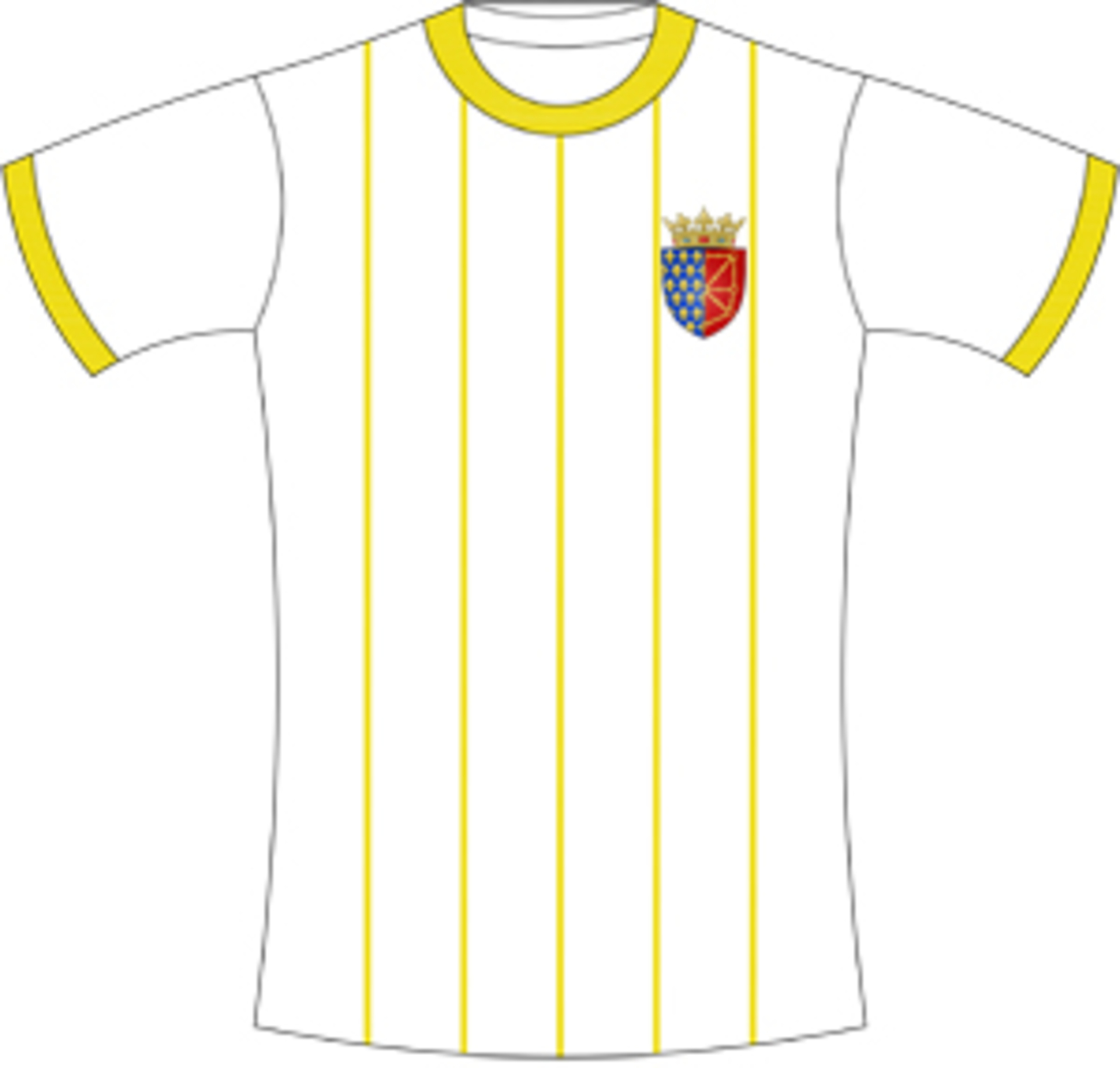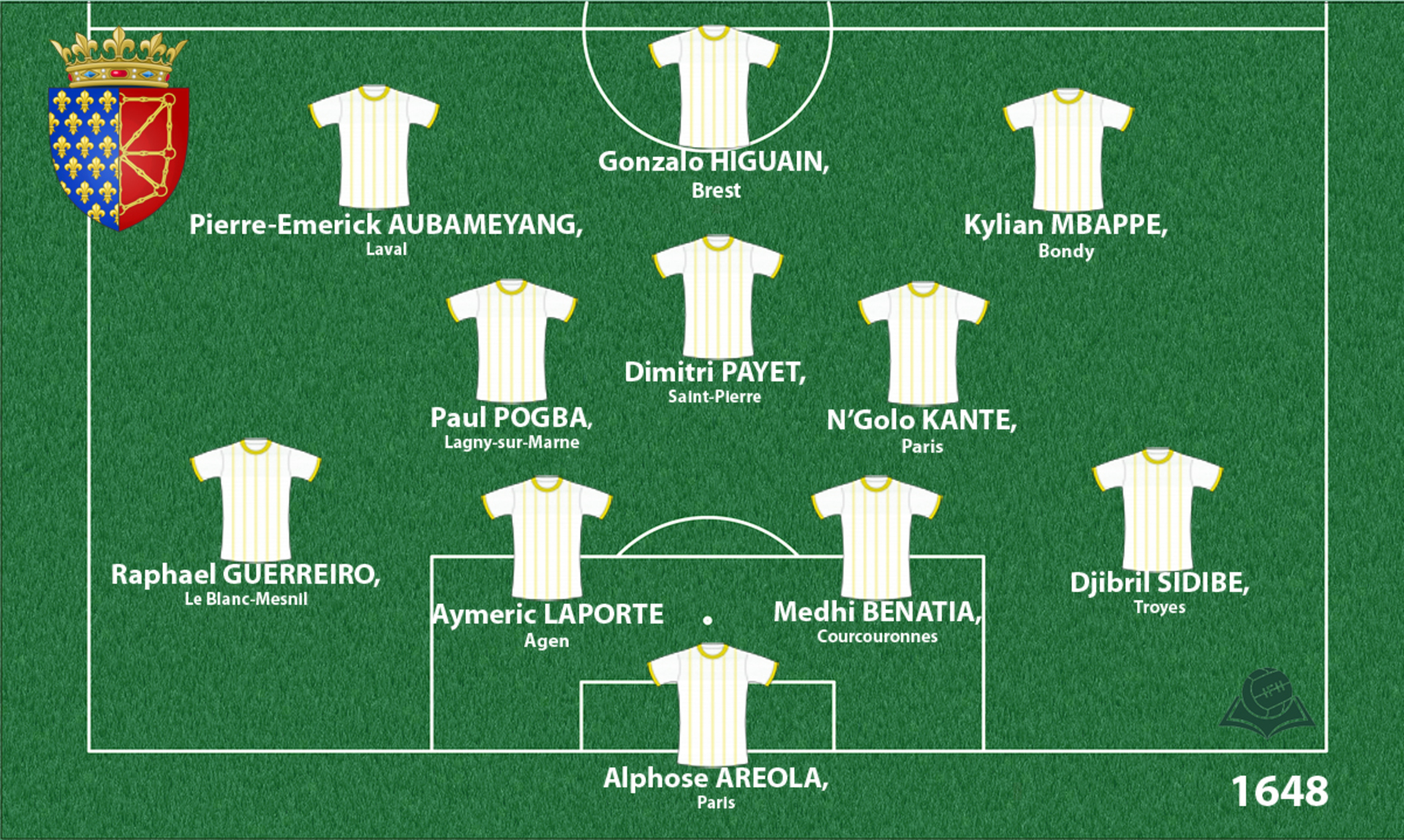The Kingdom of France
The Reformation and the Counter-Reformation deeply shook the life in France in the 16th and the 17th century. In the first half and around the mid-17th century France engaged in wars against the Austrian and Spanish branches of the Habsburgs, and came out of them not only with numerous territorial gains, but also as the biggest European continental power.

Coat of arms

Shirt
| Position | First name | Last name | Mjesto rođenja | Like | Dislike | |
|---|---|---|---|---|---|---|
| GK | Alphonse | AREOLA | Paris |
14 |
5 |
|
| GK | Benoit | COSTIL | Caen |
0 |
1 |
|
| DC | Aymeric | LAPORTE | Agen |
13 |
1 |
|
| DC | Lorient | KOSCIELNY | Tulle |
3 |
5 |
|
| DC | Medhi | BENATIA | Courcouronnes |
5 |
1 |
|
| DRC | Kurt | ZOUMA | Lyon |
3 |
1 |
|
| DLC | Lucas | HERNANDEZ | Marseille |
7 |
1 |
|
| DRL | Djibrill | SIDIBE | Troyes |
4 |
3 |
|
| DR | Sebastian | CORCHIA | Noisy-le-Sec |
0 |
2 |
|
| DL/ML | Benjamin | MENDY | Longjumeau |
9 |
3 |
|
| DL/ML | Layvin | KURZAWA | Fréjus |
8 |
3 |
|
| DL/MLC | Raphael | GUERREIRO | Le Blanc-Mesnil |
8 |
4 |
|
| DMC | N'Golo | KANTE | Paris |
19 |
2 |
|
| DMC | Steven | N'ZONZI | Colombes |
4 |
1 |
|
| DMC | Tiemoue | BAKAYOKO | Paris |
4 |
2 |
|
| MC | Adrien | RABIOT | Saint-Maurice |
5 |
1 |
|
| MC | Blaise | MATUIDI | Toulouse |
5 |
2 |
|
| MC | Paul | POGBA | Lagny-sur-Marne |
13 |
2 |
|
| MRLC | Adrien | SILVA | Angoulême |
0 |
2 |
|
| AMC | Dimitri | PAYET | Saint-Pierre (Reunion) |
1 |
1 |
|
| AMRLC | Ousmane | DEMBELE | Vernon |
4 |
4 |
|
| AMRL | Franck | RIBERY | Boulogne-Sur-Mer |
2 |
2 |
|
| AMRL | Kingsley | COMAN | Paris |
3 |
1 |
|
| AMRL | Riyad | MAHREZ | Sarcelles |
15 |
1 |
|
| AMRL | Thomas | LEMAR | Baie-Mahault (Guadeloupe) |
2 |
0 |
|
| FRLC | Alexandre | LACAZETTE | Lyon |
10 |
1 |
|
| FRLC | Anthony | MARTIAL | Massy |
14 |
4 |
|
| FRLC | Kylian | MBAPPE | Bondy |
20 |
7 |
|
| FRLC | Pierre-Emerick | AUBAMEYANG | Laval |
10 |
2 |
|
| FC | Gonzalo | HIGUAIN | Brest |
1 |
2 |
|
| FC | Karim | BENZEMA | Lyon |
9 |
3 |
(Today part of: France (without regions Nord Pas de Calais, Alsace, Lorraine and parts of French Comte)
The saying “One king, one law, one faith” was deeply entrenched in the mentality of the denizens of the kingdom. The reason why the religious conflicts in France were so ferocious is due to the fact that the most popular form of Protestantism that was spreading there was Calvinism, i.e. a radical faith which was at odds with the piety of the populace that revered the Virgin Mary and the saints. Somewhat more moderate Lutheranism in the lands of the Holy Roman Empire and Scandinavia, made for a smoother transition there, and the same can be said for Anglicanism. There was bloodshed on both sides, and it reached its peak following the slaughter of thousands of Huguenots, and after St. Bartholomew's Day massacre (1572). The religious peace was formally achieved by the Edict of Nantes (1598) which, of course, did not mean the end of hatred. The king himself, who issued the edict, was killed by a zealous Catholic (1610), after several unsuccessful assassination attempts.
During the Thirty Years’ War, France came into conflict with both branches of the Habsburgs who, among other territories, ruled the Kingdom of Spain and the Holy Roman Empire. Considering how all three states were Catholic, this is a clear indicator that the wars did not have only a religious background, but were also a battle for the supreme power over Europe. The state’s internal and foreign policies were in the hands of two cardinals: Richeleu (1624 - 1642), followed by Mazarin (1643 – 1661). After several decades of continuous fighting, France gained certain territories through peace treaties with the Austrian (1648), and then Spanish Habsburgs (1659), after which it rose to become a hegemonic power, whereas the French king gained the prominence that allowed him to play the part of a continental arbiter.
Meanwhile, there was a rebellion in France, more precisely in Paris, from 1648 to 1653, led by the opponents (frondeurs) of the absolutist rule of the Queen Mother Ana of Habsburg and the minister G. Mazarin, who had ruled the state in the name of the underage Louis XIV. After the fall of the so-called Fronde (1653), the strengthened international position of France managed to break the power of the nobility, from which had reinforced the King’s centralised rule. Thus, the foundations on which Louis XIV would build the French hegemony in Europe were set, and the seeds of absolutism in internal politics were sown.
Sources
- Grupa autora, Povijest: Počeci novog doba (16. stoljeće), knjiga IX., Zagreb 2008.,
- Ivo GOLDSTEIN, Povijest: Hrvatska povijest, knjiga XXI., Zagreb 2008.
- ''Tridesetogodišnji rat'', Velika ilustrirana enciklopedija, Zagreb, 2009., 262-263.
- ''Jules Mazarin'', http://www.enciklopedija.hr/natuknica.aspx?id=39626
- ''Fronda'', http://www.enciklopedija.hr/natuknica.aspx?ID=20727
- Grb: https://en.wikipedia.org/wiki/National_emblem_of_France
